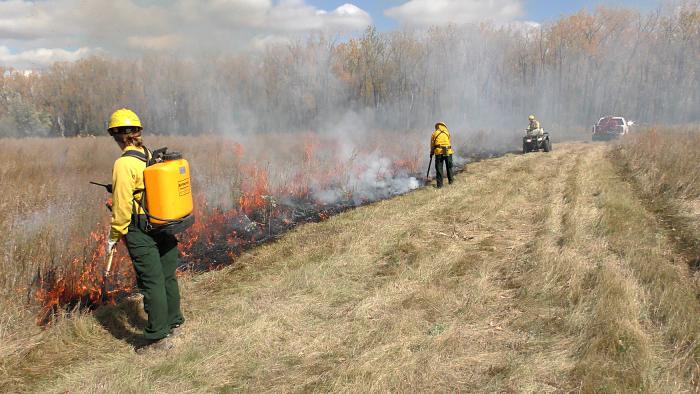Co-op Sparks Interest in Fire to Improve N.D. Grasslands for Cattle, Wildlife
NEWS RELEASE FROM USDA NRCS-NORTH DAKOTA – Dec. 8, 2020

On a sunny day last May, Craig Larson saw 110 acres of grassland on his ranch in Sheridan County, N.D., go up flames. Driven by a steady breeze, the fire chewed quickly through the heavy thatch on the soil surface. The 2-foot tall orange flames seemed alive as they leapt over each other. White smoke billowed into the blue sky.
But Larson didn’t despair.
It was a planned burn being done by the North Dakota Prescribed Fire Cooperative (NDPFC) – a coalition led by Audubon Dakota that provides landowners with prescribed burns to improve grasslands for cattle and wildlife and demonstrate the value of fire as a grassland management tool.
The USDA Natural Resources Conservation Service and Audubon Dakota created the cooperative with support from the U.S. Fish and Wildlife Service, North Dakota Game and Fish, Ducks Unlimited, Pheasants Forever and The Nature Conservancy.
Before European settlement, the prairie burned regularly, maybe once every decade, says Sarah Hewitt, Audubon Dakota conservation programs manager.
Lightning or human activity would spark fires that would burn until rain put them out or they ran into natural fire breaks.
Fire, along with grazing disturbance, helped maintain the diversity of plant species on the prairie. It suppressed cool season grasses, trees and brush and increased stands of native grasses and forbs.
“In the Northern Plains grasslands were driven by three disturbances -- grazing by large ungulates, drought and fire,” says Mark Hayek, North Dakota NRCS state rangeland management specialist. “Grazing and drought are drivers that are still in the Northern Plains today, but with fire taken out of the equation it may be the reason we are seeing a reduction in biodiversity and an increase in woody species invasion.”
Safety now
Today, safety is a big issue with fires. That’s where the NDPFC comes in.
NDPFC conducts fires for members and provides landowners, land managers, natural resource professionals and rural fire departments with prescribed fire education workshops. Staff from NRCS and other agencies and organizations teach skills necessary to conduct prescribed burns safely and effectively.
Workshop topics include:
- Fire and grassland ecology.
- Fire behavior.
- Prescribed fire equipment, practices and planning.
In Larson’s case, NDPFC experts wrote a detailed plan on how to best manage a prescribed burn on his property. Fire breaks were created. The burn boss carefully selected the perfect day for the fire. The wind was light, but steady. There was plenty of lift in the atmosphere to carry the smoke afloat and disperse it. The humidity was high enough to keep the fire from getting too hot or moving too fast. Eight experienced firefighters and trainees were on site to control the fire.
Fire impact
Larson saw a significant change in the burned rangeland. Big bluestem, Indiangrass and other native grasses germinated quickly after the heavy layer of thatch was removed. Forbs flourished. Kentucky bluegrass and bromegrasses, both invasive species to the Northern Plains, were suppressed.
“It made a difference in the quality of the grass and the amount of forage produced,” he says.
Larson has burned more than 1,700 acres of grass over the past 10 years. He has seen similar results each time. He’s convinced that fire doesn’t hurt grasslands.
“It revitalizes them,” he says.
What science says
The ultimate effect fire has on grasslands depends on several factors including where the grasslands are in the state, the time of year the burn occurs and how hot the fire gets, according to Kevin Sedivec, North Dakota State University range scientist.
In some cases, fire can replace unpalatable grasses with new, more lush plants that livestock prefer and are more nutritious. Research at the Central Grasslands Research Extension Center near Streeter and the Hettinger Research Extension Center showed higher livestock performance in cow/calf pairs grazing patch-burned areas compared to both continuous and rotational grazing management of non-burned areas.
Fire can reduce invasive grasses, such as Kentucky bluegrass and smooth bromegrass without hurting cool-season native grasses while enhancing warm-season native grasses.
When invaded tree sites are burned, native plant species composition increases as the trees die off, creating a more sustainable, properly functioning ecosystem.
In research studies conducted at Central Grasslands Research Extension Center patch burn grazing also increased floral expression of native forbs, increasing pollinator habitat for bees and butterflies while creating a heterogeneous landscape that attracted more species of birds and higher populations compared to traditional continuous grazing management.
“These benefits clearly indicate that fire is a tool that should be included in management strategies for range and grasslands in the Northern Plains,” Sedivec says. “Fire, in combination with grazing, is the best tool we have available to combat the invasion of exotic cool-season grasses and undesirable woody encroachment. We will not stop expansion of Kentucky bluegrass, smooth bromegrass, crested wheatgrass or woody encroachment onto native range without prescribed fire.”
More information
For more information about prescribed fires and the NDPFC,
contact Hewitt at the Audubon Dakota office
at Sarah.Hewitt@audubon.org or call 701-298-3373.
Media contact:
Lon Tonneson
701-361-1105
lon.tonneson@gmail.com

